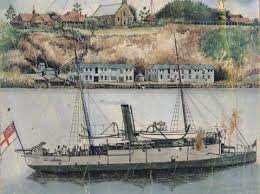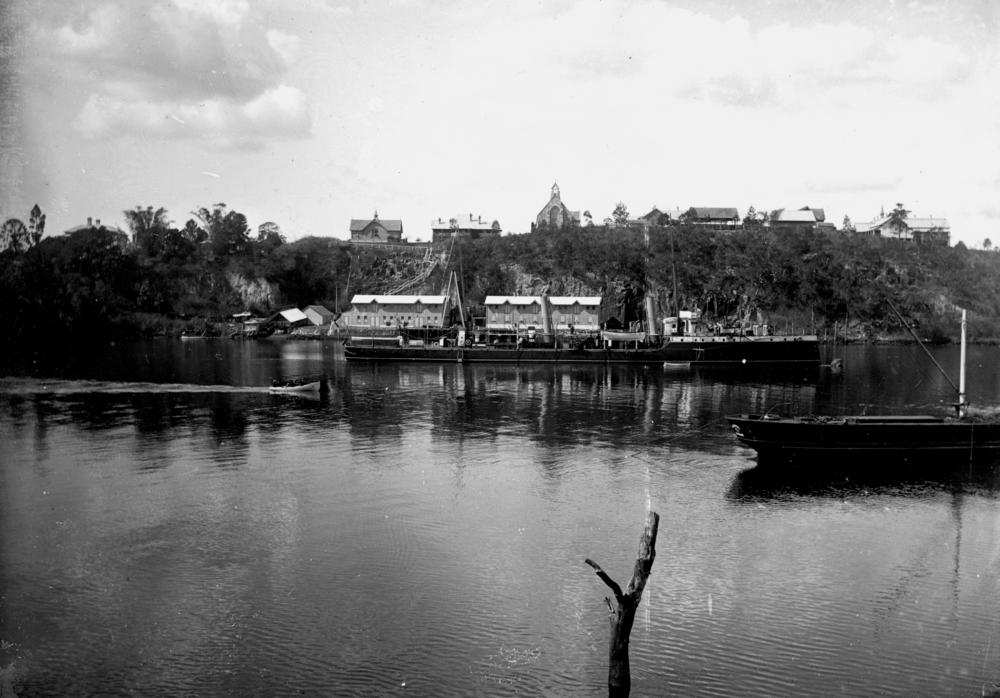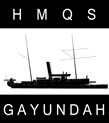
On 9 April 1903 Gayundah made history, becoming the first British warship in Australian waters to operate wireless successfully*.
The historic pioneering with the new Marconi wireless telegraph , was a combined operation by the Department of Posts and Telegraphs and the Navy. The Naval Commandant, Captain W.R. Cresswell (afterwards Rear-Admiral and known as ‘father’ of the Australian Navy) was already interested in wireless telegraphy when, in 1902, Mr C.E. Barton (an Electrical Engineer) gave a lecture and a small demonstration at the technical college.
After much techincal help from Mr Hesketh (Chief Mechanical Engineer, Electric Telegraph Department) and Mr Smith (Chief Mechanist, Electric Telegraph Office; who was also a Sub Lieutenant in the Queensland Naval Brigade), the Navy – after several experiments – was ready.
The Gayundah, fitted with a high bamboo foretop mast for transmission, proceeded down the Bay. In St. Mary’s churchyard at Kangaroo Point was a shed with Wireless Telegraph equipment and alongside it a tall mast, height 130 feet, with the aerial wire for receiving.


The first message received from a ship at sea to an Australian wireless station was transmitted by the ‘Gayundah’ in Moreton Bay to the wireless station at Kangaroo Point on Thursday 9 April, 1903.
The historic message read:
‘Gun drill continued this afternoon and was fairly successful – blowing squally and raining – prize firing tomorrow. Marconi insulators were interfered with by rain but easily rectified and communication since has been good. Good night.’
On Friday 10 April, 1903 the “Courier” reported that the Gayundah and Paluma were exercising in Moreton Bay and (quote):
“Last Evening the following message was received by pigeon post from our special representative on board the ‘Gayundah’:-
“ ‘Gayundah’ and ‘Paluma’ anchored one and half miles south of Tangalooma Point. Weather fine but very hot – perfect communication maintained with Marconi apparatus – Marconi pole stripped to refit as it is slightly bent”.
* Other possibilities
According to Lawrence Durrant (“The Seawatchers, the Story of Australia’s Coast Radio Service” by Lawrence Durrant. ISBN 0 207 15 198 9) Gayundah been exchanging Wireless Telegraphy signals with the Stores Depot at Kangaroo Point since 1900.
The honour, he says, of being the first ship “at sea” in Australian waters to transmit signals to shore belongs to HMS St George (18th May 1901).
If correct, Gayundah‘s 9 April 1903 message may be the first message regarding as being from an Australian ship “at sea”.
As one of our correspondents points out, this may be further clouded by the definition of Moreton Bay as a pilotage area. If you are in the bay, are you technically at sea?
Whatever the case, Gayundah was certainly one of the earliest wireless telegraphy equipped ships in Australia.
